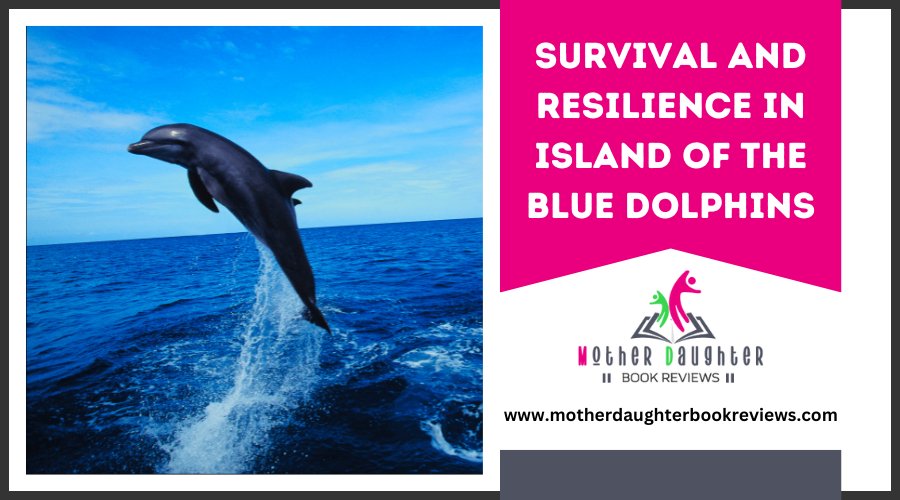Survival and Resilience in Island of the Blue Dolphins

In "Island of the Blue Dolphins" by Scott O'Dell, you'll follow young Karana as she navigates life alone on a desolate island. Stranded without her family, she builds shelter, crafts tools, and forges bonds with island creatures to combat loneliness. Each day tests her ingenuity and resolve, from fending off wild dogs to gathering food and water. Her emotional strength grows as she learns to thrive despite overwhelming odds.
Karana's Initial Struggles
Karana's initial struggles began the moment she found herself stranded on the desolate island. You can imagine the overwhelming sense of isolation she felt, surrounded only by the endless sea and deserted landscapes. The immediate challenge of being alone pushed her to confront her deepest fears. Without the comfort of human companionship, Karana had to navigate the harsh realities of survival on her own.
Every day brought new isolation challenges. You'd see her grappling with the absence of her family and community, which tested her emotional resilience. The loneliness was palpable, but it also became a catalyst for her emotional growth. Karana learned to find comfort in her surroundings, drawing strength from the natural world that enveloped her.
Her emotional growth was evident as she adapted to her new reality. You'd notice her evolving from despair to determination, slowly building inner strength. The isolation forced her to rely on herself, fostering a sense of independence and self-reliance.
Building a Shelter
Having come to terms with her solitude, the next challenge was creating a safe haven to protect herself from the elements and potential dangers. You'd initially need to reflect on the location—somewhere elevated, away from the shoreline to avoid high tides, but not too far from a freshwater source.
The shelter materials you'd use are vital. Driftwood and whale bones are strong and readily available on the island. You'd gather these materials, making sure they're sturdy enough to withstand strong winds and potential threats from wild animals. For the roof, you'd weave thick layers of kelp and grasses, providing insulation and waterproofing.
Safety reflections are paramount. You'd need to construct the entrance facing away from prevailing winds to minimize exposure to the cold. Building a low entrance can also help retain heat inside. Surrounding the shelter with a barrier of sharp stones or thorny bushes would deter animals and provide further security.
It's not just about building a structure but ensuring it's a true sanctuary. Every piece you place, every knot you tie, contributes to a space where you can find safety, warmth, and a semblance of home amidst the wild.
Crafting Survival Tools
Crafting survival tools is vital to your expedition on the island, as these instruments will aid in your daily tasks and long-term survival. You'll find that tool making techniques are fundamental for transforming natural resources into functional items that can make your life easier. Resourceful adaptations are necessary for creating these tools from the materials available on the island.
Key Tools to Craft:
- Fishing Spear: Find a sturdy branch and sharpen one end into a point. Use stones to create barbs along the tip for catching fish more effectively.
- Hunting Bow: Select a flexible piece of wood for the bow and use animal sinew or plant fibers for the string. Carve arrows from straight sticks and attach sharp stone tips.
- Stone Knife: Locate a flat stone and grind one edge against a harder rock to form a sharp blade. This will be indispensable for cutting and preparing food.
Encounters With Wild Dogs
When you come across wild dogs on the island, staying calm and evaluating the situation is crucial. Initially, observe the wild dog behavior. These dogs are part of a pack, and understanding their pack dynamics can help you predict their actions. You'll notice they often follow a leader and communicate with body language and vocalizations.
Stay still and avoid sudden movements that might provoke them. Wild dogs can be curious, but they're also cautious. If you appear non-threatening, they might lose interest. However, don't turn your back on them. Slowly back away while keeping an eye on the pack. This shows them you're not prey, but also not a threat.
If the dogs seem aggressive, look for something to defend yourself with, like a sturdy stick or a rock. Remember, wild dogs respect strength and confidence. Stand tall and make yourself seem larger. Shout or make loud noises to intimidate them if necessary.
Knowing wild dog behavior and pack dynamics allows you to navigate these encounters safely. Your calm and assertive actions can make a significant difference in ensuring your survival on the island.
Finding Food and Water
Surviving on the island hinges on your ability to find food and water. You must employ diverse foraging techniques and identify reliable water sources to stay alive. Initially, you'll need to scour the coastline for edible sea life. Mussels, abalone, and fish can be gathered from tide pools or caught with simple traps.
- Tide Pools: Look for mussels and small fish among the rocks.
- Open Ocean: Fish using a spear or makeshift net.
- Shoreline: Collect seaweed, which can be nutritious and plentiful.
On land, learn to recognize edible plants and roots. Berries, wild herbs, and tubers can provide vital nutrients. Use a stick to dig for roots and be cautious of poisonous plants.
Finding water is similarly important. Search for freshwater sources such as streams or springs. If these are scarce, dig shallow wells near the base of hills or in sandy areas where groundwater might collect. Rainwater can also be a lifeline; set up containers to catch it during storms.
The Arrival of the Aleuts
Just as you've started to master the art of foraging and finding water, a new challenge presents itself: the arrival of the Aleuts. Their motives are clear—they seek the island's rich resources, particularly its otters. This historical context sets the stage for a tense relationship, as your community must quickly adapt to this unexpected presence. The Aleuts' arrival doesn't just bring conflict; it also introduces cultural impacts, altering the dynamics of your tribe.
Survival strategies shift rapidly. Where once your focus was solely on gathering food and staying hydrated, now you must also consider the Aleuts' intentions and actions. Will they respect your land, or will their greed lead to more severe conflicts? Conflict resolution becomes crucial, demanding that you and your community find ways to negotiate or defend against potential threats.
Karana's Animal Companions
Among the many trials you face, the bond you form with animals stands out as one of the most poignant aspects of your expedition. On the isolated island, your animal friendships become an essential part of your survival, offering companionship and unwavering loyalty. Rontu, the wild dog you tame, transforms from a foe to a loyal friend, highlighting the incredible bond that can develop even in the most unlikely scenarios.
To illustrate the depth of these connections, consider these three instances:
- Rontu's loyalty: From a wild adversary to a devoted companion, Rontu's transformation is a reflection of your patience and compassion.
- Tainor and Lurai: The birds you care for symbolize hope and continuity, their songs bringing a sense of normalcy and joy.
- Mon-a-nee: The otter you rescue, later named Won-a-nee, exemplifies the tender care you extend to all living creatures, creating a circle of trust and mutual respect.
These animal friendships are more than mere survival tactics; they're loyalty bonds that underscore your resilience and empathy. By forging these connections, you enrich your life on the island, making each day a bit more bearable and profoundly meaningful.
Overcoming Loneliness
Confronting the vast emptiness of solitude on the island, you find creative ways to keep your spirit intact. The isolation might seem overwhelming at the outset, but you soon realize that building friendship bonds with the island's creatures can help ease the loneliness. Each relationship you form, regardless of whether with a sea otter or a cormorant, fills a small part of the void left by human absence.
Through these bonds, you develop emotional strength. The playful antics of your animal companions bring laughter, while their loyalty offers comfort. You learn that even in the starkest isolation, connections can be found if you're willing to look beyond traditional forms of companionship.
Creating routines also plays an essential role. Crafting tools, gathering food, and exploring the island become more than survival tasks; they're ways to keep your mind occupied and your heart hopeful. By focusing on these activities, you push back against the encroaching darkness of loneliness, replacing it with purpose and direction.
Weathering the Storms
As your bonds with the island's creatures grow stronger, you also brace yourself for the physical challenges ahead. The isolation confronts you in ways you didn't expect. Storms on the island are fierce and unforgiving, testing both your survival skills and emotional growth. You quickly learn that preparation is key to weathering these tempests.
- Securing Shelter: You fortify your cave or build a more robust structure to withstand the powerful winds and torrential rains. Every rock you place is a step toward your safety.
- Stockpiling Supplies: You gather food, water, and crucial tools, storing them in dry, secure locations. Each item can be a lifesaver when the storm rages on.
- Adapting Mindset: You mentally prepare yourself for the isolation challenges that come with being stranded during a storm. The howling winds and relentless rain can erode your spirit, but you find strength within yourself.
Lessons in Resilience
How do you find the strength to keep going when the odds are stacked against you? In "Island of the Blue Dolphins," Karana's expedition is a masterclass in resilience. You see her make courageous choices, drawing from deep within her survival instincts. Alone on an island, she faces numerous challenges—from finding food to defending herself against wild animals.
Each day, Karana's actions demonstrate that resilience isn't just about enduring hardship; it's about adapting and growing stronger. When she initially finds herself stranded, fear and uncertainty are her initial companions. Yet, she doesn't succumb. Instead, she learns to hunt, build shelter, and create tools, turning her isolation into a reflection of human spirit.
Karana's ability to stay positive and resourceful is crucial. She acknowledges her fears but doesn't let them paralyze her. By observing her surroundings and using her intellect, she transforms obstacles into opportunities for survival.




